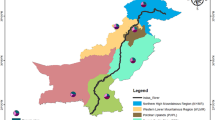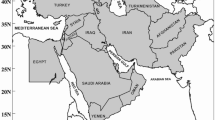Abstract
The plant diversity of western Madhya Pradesh is reducing at the fast rate due to anthropogenic disturbances and environmental degradation. Disturbance is a major factor responsible for the fragmentation of forest vegetation; as a result, there is a preponderance of small patches, and some of them are still preserved as sacred groves because of strong religious beliefs held by the indigenous people of Jhabua district of western Madhya Pradesh. Dungari mata sacred grove is situated near Katthiwada village in Jhabua district of western Madhya Pradesh that considered being residence of local deities. The Bhil and Bhilala are the most dominant tribe of the study area and depend upon the forest resources for their livelihood. About 339 species, 286 genera and 82 families were found in the grove. Fabaceae (38 species), Poaceae (33 species) and Asteraceae (20 species) were dominant families, and the Ipomoea was the largest genus, with five species. About 69 tree species, 25 shrubs, 157 herbs, 40 grasses, 3 epiphytes and 45 climbers and lianas were found in the groves. Some threatened plant species are growing over here that are not found elsewhere, and they comes under various threat categories. About threatened taxa, 81 species were recorded from the grove that comes under various threat categories. The present status of the grove is of concern, as it is gradually declining under constant anthropogenic pressure. Their better management and protection are important for the conservation of plant diversity in the region and also for the benefit of indigenous tribes of the state.










Similar content being viewed by others
References
Bhakat RK (1990) Tribal ethics of forest conservation. Yojana 23–27
Boojh R, Ramakrishan PS (1983) Sacred groves and their role in environmental conservation. In: Strategies for environmental management. Souvenir Vol. Department of Science and Environmental of Uttar Pradesh, Lucknow, pp 6–8
Cooke T (1901–1908) The flora of the presidency of Bombay, Vol 1–3. Taylor & Francis, London
Dhingra KK (1986) Flora of Gwalior (Angiospermic) (Thesis). Jiwaji University, Gwalior
Duthie JF (1903–1929) Flora of upper gangetic plain and the adjacent of Siwalik and Sub-Himalayan tracts, Vol 1–3. Government press, Calcutta
Farnsworth NR (1988) Screening plants for new medicines. In: Wilson EO (ed) Biodiversity. National Academy Press, Washington DC, pp 83–97
Friedman J, Yaniv Z, Dafni A, Palewitch D (1986) A preliminary classification of the healing potential of medicinal plants, based on the rational analysis of ethnopharmacological field survey among Bedouins in Negev Desert, Israel. J Ethnopharmacol 16:275–287
Gadgil M, Vartak VD (1975) Sacred groves of India: a plea for continued conservation. J Bombay Nat Hist Soc 72:314–320
Gadgil M, Vartak VD (1976) The sacred groves of Western Ghats in India. Econ Bot 30:152–160
Gedif T, Hahn H (2003) The use of medicinal plants in self-care in rural central Ethiopia. J Ethnopharmacol 87:155–161
Godbole A (1996) Role of tribals in preservation of sacred forests. In: Jain SK (ed) Ethnobiology in human welfare. Deep Publications, New Delhi, pp 345–348
Haridasan K, Rao RR (1985) Forest flora of Meghalaya, vol 1. Bishen Singh and Mahendra Pal Singh, Dehra Dun
Heinrich M, Ankli A, Frei B, Weimann C, Sticher O (1998) Medicinal plants in Mexico: healer’s consensus and cultural importance. Soc Sci Med 47:1863–1875
Hooker JD (1872–1897) The flora of British India, Vol I–VII. Reeve & Co, London
Hughes DJ, Chandran Subash MD (1997) Sacred groves around the earth: an overview. Workshop on the role of sacred groves in conservation and management of Biological Resources. Kerala Forest Research Institute, Peechi, Kerala, India
IUCN (1994) Red list Categories. IUCN Publications, Switzerland
IUCN (2005) Guidelines for using the IUCN Red List categories and criteria. April 2005. IUCN-SSC
Jain AK (1978) Study on vegetation of certain areas of Chambal ravines (Thesis). Jiwaji University, Gwalior
Jain SK (1988) Detailed proforma of field work in Ethnobotany. IInd training course in Ethnobotany, Lucknow, 10–18 March
Jain AK, Patole SN (2001) Some threatened plants of Pachmarhi Bioreserve of Madhya Pradesh. J Indian Bot Soc 80:151–155
Jain SK, Rao RR (1977) A hand book of field and herbarium methods. Today and tomorrows Printers and Publishers, New Delhi
Jain AK, Vairale MG (2007) Some threatened angiospermic taxa of Chambal eco-region. Phytotaxonomy 07:107–110
Jain AK, WaghVV Kadel C (2011) Conservation status of some miniature sacred groves in Jhabua district (M.P.). Ethnobotany 23:106–115
Jeeva S, Mishra BP, Venugopal N, Laloo RC (2005) Sacred forests: traditional ecological knowledge heritage in Mehalaya. J Scott Res Forum 1:93–97
Jeeva S, Mishra BP, Venugopal N, Kharlukhi L, Laloo RC (2006) Traditional knowledge and biodiversity conservation in the sacred groves of Meghalaya. Indian J Tradit Knowl 5:563–568
Kadel C (2006) Ethnobotanical studies on tribal communities of Jhabua district (M.P.) (Thesis). Jiwaji University, Gwalior
Kadel C, Jain AK (2006) Plants used in ethnoveterinary practices in Jhabua District, Madhya Pradesh. Ethnobotany 18(1&2):149–152
Khan ML, Menon S, Bawa KS (1997) Effectiveness of the protected area network in biodiversity conservation: a case study of Meghalaya state. Biodiv Conserv 6:853–868
Khanna KK, Kumar A (2000) A additions to the taxa of angiosperms: flora of Madhya Pradesh–Vol. II. J Econ Taxon Bot 24:177–180
Khanna KK, Kumar A (2006) Floristic analysis of Angiosperms from Madhya Pradesh. Bionature 26(1):13–20
Khiewtam RS, Ramakrishnan PS (1989) Socio-cultural studies of the sacred groves at Cherrapunji and adjoining areas in North-Eastern India. Man in India 69(1):64–71
King-Oliver IED, Chitra V, Narasimha D (1997) Sacred groves: traditional ecological heritage. Int J Ecol Environ Sci 23:463–470
Kosambi DD (1962) Myth and reality. Popular Press, Bombay
Kushalapa CG, Bhagwat SA, Kushalapa KA (2001) Conservation and management of sacred groves of Hodagu, Karnataka, South India-a unique approach. In: Ganeshaiah KN, Shaanker Uma R, Bawa KS (eds) Tropical ecosystems: structure, diversity and human welfare. Oxford IBH Publishing Co. Pvt. Ltd, New Delhi, pp 565–569
Lawrence GHM (1951) Taxonomy of vascular plants. Macmillan, New York
Malhotra KC (1998) Anthropological dimensions of sacred groves in India: an overview. In: Ramakrishan PS, Saxena KG, Chandrasekhar U (eds) Conserving the sacred: for biodiversity management. UNESCO and Oxford IBH Publishing Co. Pvt. Ltd, New Delhi, pp 423–438
Martin G (1995) Ethnobotany: a method manual. Chapman and Hall, London
Musa MS, Abdelrasool FE, Elsheikh EA, Ahmed LAMN, Mahmoud ALE, Yagi SM (2011) Ethnobotanical study of medicinal plants in the Blue Nile State, South-eastern Sudan. J Med Plants Res 5:4287–4297
Muthu A, Ignacimuthu S (2005) Traditional knowledge of Kani tribals in Kouthalai of Tirunelveli hills, Tamil Nadu, India. J Ethnopharmacol 102:246–255
Muthu C, Ayyanar M, Raja N, Ignacimuthu S (2006) Medicinal plants used by traditional healers in Kancheepuram District of Tamil Nadu, India. J Ethnobiol Ethnomed 2:43
Panghal M, Vedpriya A, Sanjay Y, Sunil K, Jaya PY (2010) Indigenous knowledge of medicinal plants used by Saperas community of Khetawas, Jhajjar District, Haryana, India. J Ethnobiol Ethnomed 6:4
Patole SN (2002) Studies on Biodiversity of Pachmarhi forest (M.P.) with special reference to threatened and rare plants (Thesis). Jiwaji University, Gwalior
Pushpangadan P (1995) Ethnobiology in India: a status report. Government of India, New Delhi
Raghavaiah V (1956) How to approach the Adivasi. Vanyajati 4:31–38
Raizada MB (1966) Hints for botanical collectors. Forest Research Institute Press, Dehradun
Rodgers WA (1994) The sacred groves of Meghalaya. Man in India 74:339–348
Samvatsar S (1996) The flora of western tribal (M.P.). Scientific Publishers, Jodhpur
Sharma MP, Ahmad J, Hussain A, Khan S (1992) Folklore medicinal plants of Mewat (Gurgaon Districts), Haryana, India. Int J Pharmacogn 2:129–134
Sikarwar RLS (1990) Botany of Morena district (Thesis). Jiwaji University, Gwalior
Sinha B, Maikhuri RK (1998) Conservation through ‘socio-cultural-religious practice’ in Garhwal Himalaya: a case study of Hariyali sacred grove’. In: Ramakrishan PS, Saxena KG, Chandrasekhar U (eds) Conserving the sacred: for biodiversity management. UNESCO and Oxford IBH Publishing Co Pvt Ltd, New Delhi, pp 289–299
Srithi K, Balslev H, Wangpakapattanawong P, Srisanga P, Trisonthi C (2009) Medicinal plant knowledge and its erosion among the Mien (Yao) in northern Thailand. J Ethnopharmacol 123(2):335–342
Sunitha S, Rao RPB (1999) Sacred groves in Kurnool District, Andhra Pradesh. In: Sivadasan M, Philip M (eds) Biodiversity, taxonomy and conservation of flowering plants. Mentor books, Calicut, pp 367–373
Tiwari BK, Barik SK, Tripathi RS (1998a) Biodiversity value, status and strategies for conservation of sacred groves of Meghalaya, India. Ecosyst Health 4:20–32
Tiwari BK, Barik SK, Tripathi RS (1998b) Sacred groves of Meghalaya. In: Ramakrishnan PS, Saxena KG, Chandrashekara UM (eds) Conserving the sacred: for biodiversity management. UNESCO and Oxford IBH Publishing Co Pvt Ltd, New Delhi, pp 253–262
Upadhyay PB, Roy S, Kumar A (2007) Traditional uses of medicinal plants among the rural communities of Churu district in the Thar Desert, India. J Ethnopharmacol 113:387–399
Upadhyay B, Parveen R, Dhaker AK, Kumar A (2010) Ethnomedicinaland ethnopharmaco-statistical studies of Eastern Rajasthan, India. J Ethnopharmacol 129:64–86
Vartak VD, Gadgil M (1973) Dev Rahati: an ethnobotanical study of the forests preserved on grounds of religious beliefs. In: Proceeding of Indian Science Congress, vol 60, p 341
Vartak VD, Kumbhojkar MS, Dabadghao V (1986) Sacred groves: a sanctuary for lofty trees and lianas. In: Jain SK (ed) Proceedings of the seminar on ecodevelopment of Western Ghats. Pawan Kumar Publications, Jodhpur, pp 329–335
Verma DM, Balakrishnan NP, Dixit RD (1993) Flora of Madhya Pradesh Vol. I. Botanical Survey of India, Calcutta
Wagh VV, Jain AK (2014a) Herbal remedies used by the tribal people of Jhabua district, Madhya Pradesh for the treatment of joint diseases. In: Sanjeev Kumar (ed) Ethnobotanical studies in India. Deep Publication, New Delhi, pp 161–164
Wagh VV, Jain AK (2014b) Ethnomedicinal uses of underground plants parts in Jhabua district, Madhya Pradesh, India. Adv Biol Res 8(4):151–156
Whittaker RH (1975) Communities and ecosystems. Macmillan Publishing Company, New York
World Health Organization (2002–2005) WHO Traditional medicine strategy Report, Document WHO/EDM/TRM/2002.1
Yineger H, Kelbessa E, Bekele T, Lulekal E (2007) Ethnoveterinary medicinal plants at Bale Mountains National Park, Ethiopia. J Ethnopharmacol 112:55–70
Acknowledgments
The authors are thankful to Director, CSIR-National Botanical Research Institute, Lucknow, for encouragement and providing facilities to carry out the work. Thanks are also due to Divisional Forest Officer, Jhabua (M.P.), for extending facilities during the field work. The cooperation of tribal’s of Jhabua district is deeply acknowledged for this work.
Author information
Authors and Affiliations
Corresponding author
Rights and permissions
About this article
Cite this article
Wagh, V.V., Jain, A.K. Inventory of ethnobotanicals and other systematic procedures for regional conservation of medicinal and sacred plants. Environ Syst Decis 35, 143–156 (2015). https://doi.org/10.1007/s10669-015-9538-5
Published:
Issue Date:
DOI: https://doi.org/10.1007/s10669-015-9538-5




